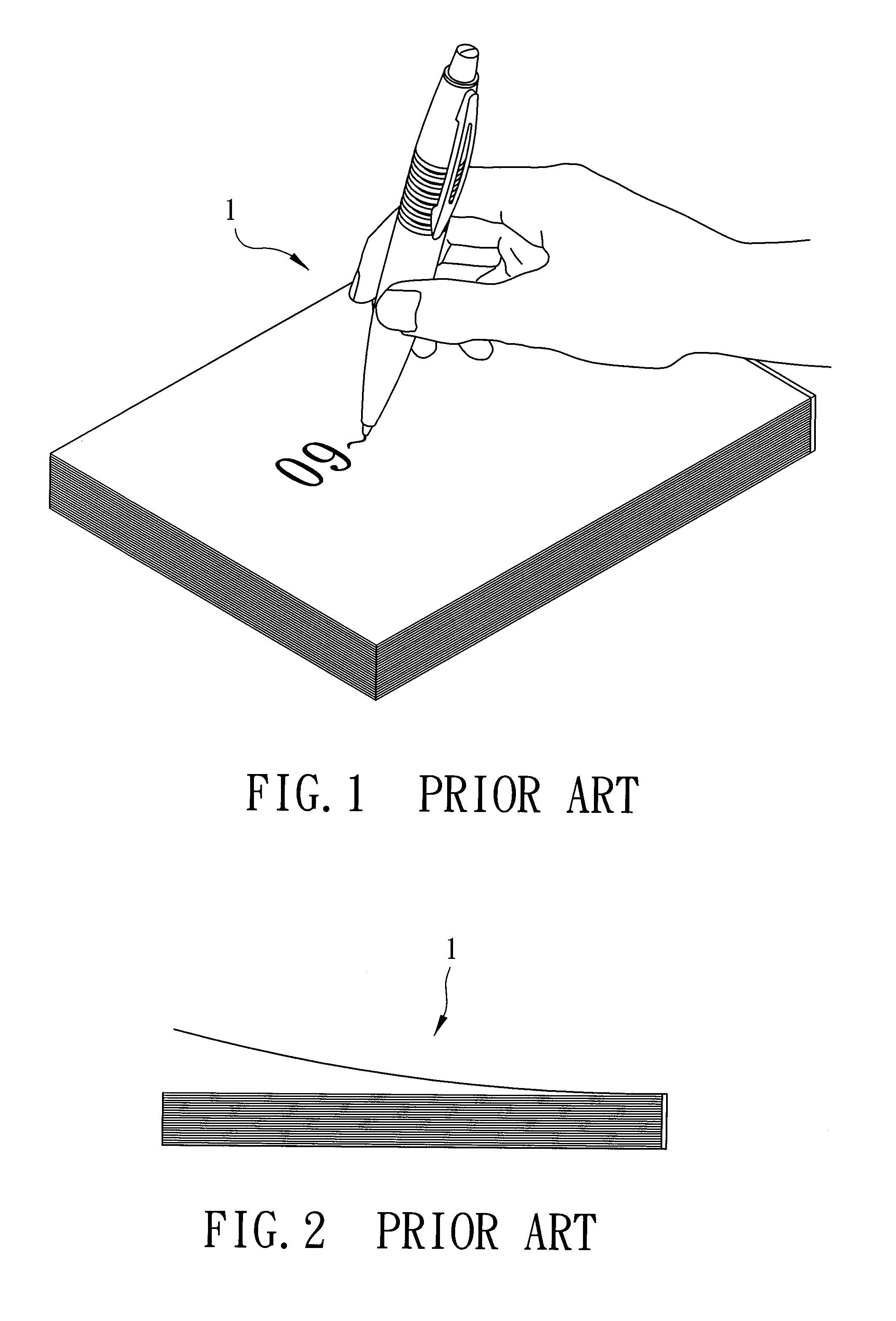Note pad containing carbonless color-developing material
- Summary
- Abstract
- Description
- Claims
- Application Information
AI Technical Summary
Benefits of technology
Problems solved by technology
Method used
Image
Examples
experiment 1
[0036]In Experiment 1, five note pads 2 (Examples 1 to 5) were subjected to a typewriter test for evaluating a color developing effect of the carbonless note sheets 3. Details of the typewriter test are disclosed in U.S. Pat. No. 4,087,376. In Experiment 1, each of the note pads 2 has upper and lower carbonless note sheets 3 on which were printed some characters using a dot matrix printer (EPSON LQ-2080C). The color developing effect for each of Examples 1 to 5 was evaluated using an automatic reflectometer (Model TR-600, Tokyo Denshoku K. K.).
[0037]In each of Examples 1 to 5, characters were directly printed on the upper carbonless note sheet 3 using a pressure close to that of human writing (i.e., the scale of the printer was set to zero). Furthermore, the substrates 31 of Examples 1 to 5 are all made of paper and respectively have the following basic weights: 40 g / m2, 60 g / m2, 80 g / m2, 100 g / m2, and 120 g / m2. In each of Examples 1 to 5, the microcapsules 321 have an average diame...
experiment 2
[0040]In Experiment 2, a static pressure test was conducted on each carbonless note sheet 31 for evaluating whether or not the carbonless note sheet 31 is stainable easily by accidental pressure such as rubbing or hitting force. The static pressure test was conducted by: (a) measuring a first HW value of the carbonless note sheet 31 before a static pressure is applied to the carbonless note sheet 31 for one minute, (b) measuring a second HW value of the carbonless note sheet 31 after application of the static pressure, and (c) obtaining a HW difference between the first and second HW values. The first and second HW values were obtained using the automatic reflectometer. In Examples 6 to 11, the weight percentage of the microcapsules 321 in the coating material of the color-developing coating layer 32 was 34.10%. The amounts and average diameters of the microcapsules 321 were varied in Examples 6 to 11 as shown in Table 2. The substrates 31 in Examples 6 to 5 11 are made of paper and...
experiment 3
[0042]In Examples 12 to 20, the color-developing coating layers 32 were formed from coating materials containing different percentages of the microcapsules 321 as shown in Table 3. The substrates 31 of the examples have a basic weight of 80 g / m2.
[0043]Examples 12 to 20 were tested using the typewriter test and the static pressure test. The test results are shown in Table 3. The background (unprinted area) of each carbonless note sheet 3 in Examples 12 to 20 has the HW value of about 83.
[0044]As shown in Table 3, when the weight percentage of the microcapsules 321 is lower than 30%, the upper carbonless note sheets 3 of the examples have poor color development. When the weight percentage of the microcapsules 321 is higher than 50%, the lower carbonless note sheets 3 of the examples have significant color development. On the other hand, when the weight percentage of the microcapsules 321 in the coating material is higher than 50%, the HW difference under the static pressure of 7 kgf / c...
PUM
| Property | Measurement | Unit |
|---|---|---|
| diameter | aaaaa | aaaaa |
| diameter | aaaaa | aaaaa |
| diameter | aaaaa | aaaaa |
Abstract
Description
Claims
Application Information
 Login to View More
Login to View More - R&D
- Intellectual Property
- Life Sciences
- Materials
- Tech Scout
- Unparalleled Data Quality
- Higher Quality Content
- 60% Fewer Hallucinations
Browse by: Latest US Patents, China's latest patents, Technical Efficacy Thesaurus, Application Domain, Technology Topic, Popular Technical Reports.
© 2025 PatSnap. All rights reserved.Legal|Privacy policy|Modern Slavery Act Transparency Statement|Sitemap|About US| Contact US: help@patsnap.com



